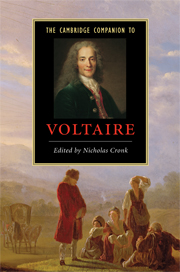Book contents
- Frontmatter
- Introduction
- 1 The making of a name: a life of Voltaire
- 2 Voltaire and authorship
- 3 Voltaire: philosopher or philosophe?
- 4 Voltaire and clandestine manuscripts
- 5 Voltaire and the myth of England
- 6 Voltaire’s masks: theatre and theatricality
- 7 Voltaire as story-teller
- 8 Candide
- 9 Voltaire and history
- 10 Voltaire’s correspondence
- 11 Voltaire: pamphlets and polemic
- 12 Voltaire and the politics of toleration
- 13 Voltaire and the Bible
- 14 The Voltaire effect
- Further reading
- Index
Introduction
Published online by Cambridge University Press: 28 May 2009
- Frontmatter
- Introduction
- 1 The making of a name: a life of Voltaire
- 2 Voltaire and authorship
- 3 Voltaire: philosopher or philosophe?
- 4 Voltaire and clandestine manuscripts
- 5 Voltaire and the myth of England
- 6 Voltaire’s masks: theatre and theatricality
- 7 Voltaire as story-teller
- 8 Candide
- 9 Voltaire and history
- 10 Voltaire’s correspondence
- 11 Voltaire: pamphlets and polemic
- 12 Voltaire and the politics of toleration
- 13 Voltaire and the Bible
- 14 The Voltaire effect
- Further reading
- Index
Summary
The French seventeenth century is commonly referred to as 'the age of Louis XIV' - indeed it was Voltaire who popularised the expression. But the eighteenth century is rarely described as the age of Louis XV: it is, by common consent, 'the age of Voltaire'. Commenting on this anomaly, in a speech to mark the centenary of Voltaire's death in 1878, Victor Hugo declared that until Voltaire's time, centuries always bore the names of heads of state; but, he went on, 'Voltaire is more than a head of state, he is a head of ideas' ('Voltaire est plus qu'un chef d'états, c'est un chef d'idées'). The essays in this volume will explore how one writer came to occupy such a dominant position in his century, and to exercise such continuing influence.
No eighteenth-century writer was depicted more often than Voltaire; and no image of him has greater iconic status than the bust sculpted by Jean-Antoine Houdon (fig. 1). In fact, there is not one bust but a whole assortment of them, in various materials and presentations; the number of surviving portrait busts makes clear that Voltaire was Houdon's best-selling subject. Mme Denis, Voltaire's niece and mistress, even commissioned a full-length version, the large seated statue in marble which now dominates the first-floor foyer of the Comédie-Française. Voltaire's head, wearing no wig, is turned to the right, his eyes in a piercing glance, his lips drawn tightly in a smile. So potent and so omnipresent was this image that writers in the nineteenth century not only debated Voltaire's ideas, they argued about his smile. The Romantic poet Alfred de Musset famously described Voltaire's 'hideous smile'. Joseph de Maistre evidently had the phrase in mind when he spoke of Voltaire's 'ghastly grin' ('rictus épouvantable'), a phrase which Gustave Flaubert quotes when he mocks the received bourgeois wisdom concerning the writer whom he admired: 'Voltaire: Superficial knowledge.
- Type
- Chapter
- Information
- The Cambridge Companion to Voltaire , pp. 1 - 16Publisher: Cambridge University PressPrint publication year: 2009

